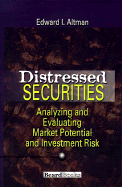|
PREFACE |
vii |
|
|
|
| 1 |
Background of the Distressed Securities Market and
Summary of Major Findings |
1 |
| . |
Size of the Market |
2 |
|
Supply of Distressed Securities |
3 |
|
Distressed Security Investor Profile |
4 |
|
Returns on Distressed Securities Investment Strategies |
6 |
|
Market Importance and Outlook |
8 |
|
|
|
| 2. |
Supply of Distressed Securities |
12 |
|
Bankrupt Companies and Business Failures |
12 |
|
Junk Bond Defaults |
13 |
|
Distressed Securities by Yield |
17 |
|
Publicly Traded Debt Securities |
18 |
|
Private Debt |
18 |
|
Trade Debt Claims |
20 |
|
Conclusion |
23 |
|
|
|
| 3. |
Demand for Distressed Securities |
25 |
|
Questionnaire Results |
25 |
|
Involuntary Investors |
27 |
|
Providers of New Capital-DIP Financing |
27 |
|
|
|
| 4. |
Price Levels and Recovery Rates on Defaulted Securities |
31 |
|
Capital Structures |
32 |
|
Recovery Rates |
32 |
|
|
|
| 5. |
The Market for Defaulted Private Trade and Bank Debt |
37 |
|
Public and Private Debt |
38 |
|
Markets for Public Debt |
39 |
|
Bankruptcy Rules |
39 |
|
Judge Lifland's Court |
43 |
|
Proposed Changes to Rule 3001 (e) (2) |
44 |
|
Direct Assignments |
44 |
|
Participations |
47 |
|
Trading Pre-and Post-Petition Bank Debt |
47 |
|
Unregistered Securities |
48 |
|
Representations and Warranties |
49 |
|
Opportunities for Profit |
50 |
|
Other Regulation |
50 |
|
Heightened Bankruptcy Court Supervision |
51 |
|
Functions of the Private Debt Market |
52 |
|
Benefits for the Seller |
53 |
|
Benefits for the Buyer |
54 |
|
|
|
| 6. |
The Performance of Distressed Securities |
55 |
|
Target and Minimum Rates of Return |
56 |
|
Historical Performance: Review of Literature |
57 |
|
New Test of Distressed Debt Investment Strategies |
61 |
|
The Zeta (r) Credit Evaluation Tool |
69 |
|
Investing in Distressed Debt Using ZETA (r) Scores |
71 |
|
Junk Bond Portfolio Selections |
71 |
|
How Can Rigorous Credit Analysis Help? |
78 |
|
The ZETA (r) Test |
78 |
|
|
|
| 7. |
An Index of Defaulted Straight Debt Securities |
83 |
|
A Defaulted Straight Corporate Debt Index |
84 |
|
Market Value Weighting and Return Bias |
90 |
|
Size and Returns |
90 |
|
Diversification Benefits: Correlation with Other
Strategies |
91 |
|
|
|
| 8. |
Fallen Angels: Are They All Created Equal? |
93 |
|
Purpose of the Research |
95 |
|
Evolutionary vs. Revolutionary Downratings |
97 |
|
Some Basic Questions for Investors About Fallen
Angels |
98 |
|
Prior Studies on Fallen Angels |
99 |
|
Empirical Results |
101 |
|
Total Return Performance |
109 |
|
Credit Deterioration vs. Event-Risk |
109 |
|
Pre-Downrating Loss in Wealth |
110 |
|
Utilities vs. Non-Utilities |
112 |
|
BB vs. B-Rated Downgrades |
113 |
|
Relative Performance: Excess Return Analysis |
116 |
|
Event-Risk vs. Credit Deterioration |
118 |
|
Utilities vs. Non-Utilities |
118 |
|
BB vs. B |
118 |
|
Downtick Perfomance |
121 |
|
Concluding Remarks |
121 |
|
|
|
| 9. |
Default Rates and Fixed Income Performance |
123 |
|
Traditional Measures of Default Rates and Losses |
125 |
|
Default Rates |
126 |
|
Default Losses |
126 |
|
Questions Related to the Traditional Method |
132 |
|
Mortality/Aging Approaches |
133 |
|
Comparison of Results |
134 |
|
Aging and Defaults |
138 |
|
Returns |
140 |
|
Blume and Keim Study |
142 |
|
Cheung and Bencivenga Study |
145 |
|
Positive Spreads |
145 |
|
And Now for the Future |
146 |
|
A Different Kind of Simulation |
148 |
|
Concluding Remarks |
151 |
|
|
|
| 10. |
Outlook and Conclusion |
155 |
|
Supply Forces |
155 |
|
Estimating Supply from the Z-Score Bankruptcy Indicator |
156 |
|
Z-Score Model Description |
157 |
|
Demand Forces |
160 |
|
Questionnaire Response on the Outlook |
162 |
|
|
|
|
APPENDIXES |
173 |
|
|
|
|
INDEX |
231 |
